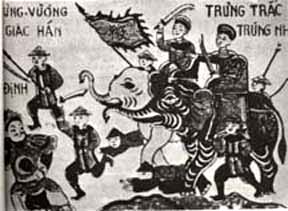The Top 10 Real Warrior Princesses
1. Myrene – queen of the Hesperian Amazons. Originating in the Canaries, they conquered parts of Syria, Egypt and Turkey, as well as the islands of Sámos, Lesbos, Patmos and Samothrace. Their military power was written of by Herodotus in the 6th century B.C. Several cities bore her name, including Smyrna (now Izmir). The earliest account of troops riding horses into combat is a North African battle in which she led a cavalry of 30,000 women.

2. Trung Trac and Trung Nhi – Vietnamese heroines. [right] In A.D. 39 the Trung sisters, widows of local aristocrats, led 80,000 peasants into battle to defeat Chinese ruler, To Dinh. Having taken over 65 fortified towns, they trained 36 women, including their mother, as generals. Eventually defeated by the sheer weight of Chinese reinforcements, they chose suicide to capture. They became a symbol of Vietnamese nationalism and the anniversary of their deaths is still commemorated with a festival. “Trung” has the same undertones in Vietnam that “Amazon” has in the West.
3. Boudicca – queen of the Iceni. On the death of her husband, Prasutagus, the Romans seized her territory: Boudicca was tortured, her daughters raped, and the Iceni nobles enslaved. She gathered an army, destroyed the colony of Camulodunum (now Colchester), sacked Londinium and Veralamium (London and St Albans), and, according to the historian Tacitus, killed 70,000 Romans. The governor, who had been in Anglesey, advanced against the queen and destroyed her force. In despair, Boudicca killed herself by taking poison.
4. Septima Zenobia – governor of Syria (about A.D. 250-275). Led her army on horseback wearing full armor; whipped the Roman legions of Claudius so badly that he retreated from much of Asia Minor. His successor, Aurelian, sent his best troops to conquer her – it took almost 4 years before her capital, Palmyra, fell. Zenobia was paraded through Rome in chains and exiled to Tibur. However, her daughters married influential families and her line was important in Roman politics for centuries.
5. Jehanne la Pucelle – Maid of Orleans. Somehow, this 16 year old peasant girl convinced the French Dauphin to give her an army, vowing to reclaim Orleans from the English and have him crowned king at Rheims. Insane? Perhaps. But in July 1429, he became Charles VII as promised. Captured by the Burgundians, she was sold to the English and charged with heresy, blasphemy, idolatry, and sorcery. Originally sentenced to life imprisonment, after “relapsing” by wearing men’s clothing, she was burned at the stake in May 1431.
6. Margaret of Anjou – the White Rose. Wife of Henry VI, she led Lancastrian armies during the War of the Roses, defeating both the Duke of York and the Earl of Warwick. In 1471 she landed at Weymouth expecting to join up with Jasper Tudor, but he was delayed and Margaret’s greatly outnumbered forces were beaten. She fled the field on foot carrying her infant son and escaped to Flanders. She returned to England with a new army, but was captured by the Yorkists; they let Louis XI of France ransom her, after obtaining her oath that she would cease fighting.

7. Mary Frith – “Moll Cutpurse”. One of the first highwaymen (or women), and possibly also the first female to smoke tobacco. Originally a pickpocket, she decided a solitary career would pose fewer risks, and switched to robbery, but only ever attacked Roundheads, and others opposed to the King, with Hounslow Heath, west of London, her main haunt. After her arrest and liberation (in those days, almost any prisoner could buy freedom), she settled down as a fence of stolen goods – then a relatively legitimate profession. Her life became a successful play, The Roaring Girl, and she died in 1659, aged 75.
8. Marie-Angelique Brulon – defender of Corsica. Fought seven campaigns between 1792 and 1799, at first as a man, but by the time she was discovered, she was so valuable in battle she was allowed to remain, fighting openly as a woman. The male troops she commanded drew up a testimonial: “We, the garrison at Calvi, certify that Marie-Angelique Josephine Duchemin Brulon, acting sergeant, commanding the attack on Fort Gesco, fought with us with the courage of a heroine”, and commended her skill with a sword and in hand to hand combat. Promoted to lieutenant in 1822 and personally presented the French Legion of Honor by Napoleon III.
9. Flora Sanders – Englishwoman abroad. Fought in the trenches with the Serbian army during World War I, while in her forties. Had risen to the rank of corporal in charge of a platoon when she was severely injured by a grenade in August 1916. She was hospitalized, given Serbia’s highest military decoration, the Kara George Star, and promoted to sergeant-major. Returned to the front after recovering from her wounds.
10. Nancy Wake – the “White Mouse”. Born in New Zealand, she married a Frenchman, and joined the Resistance during World War II. Parachuting into France in March 1944, she took virtual command of the Maquis d’Auvergne, a 7,000 strong resistance group. A comrade said of her, “She is the most feminine woman I know – until the fighting starts. Then she is like five men!” Took part in a raid on Montlucon Gestapo headquarters, which left thirty-eight Germans dead, and also killed a man with her bare hands. Her George Medal citation said, “Wake’s organizing ability, endurance, courage and complete disregard for her own safety earned her the respect and admiration of all”. She was also awarded the Croix de Guerre by France no fewer than three times.